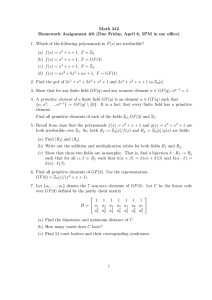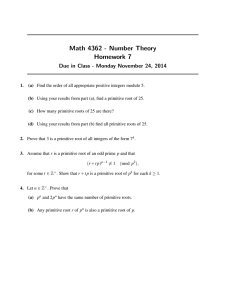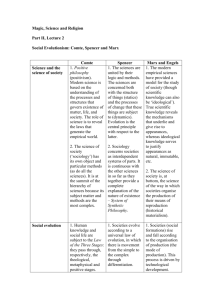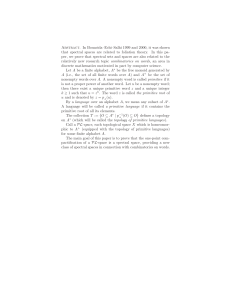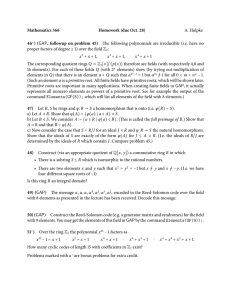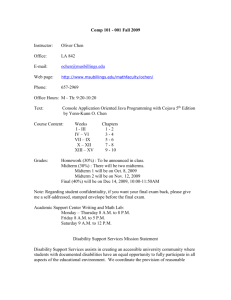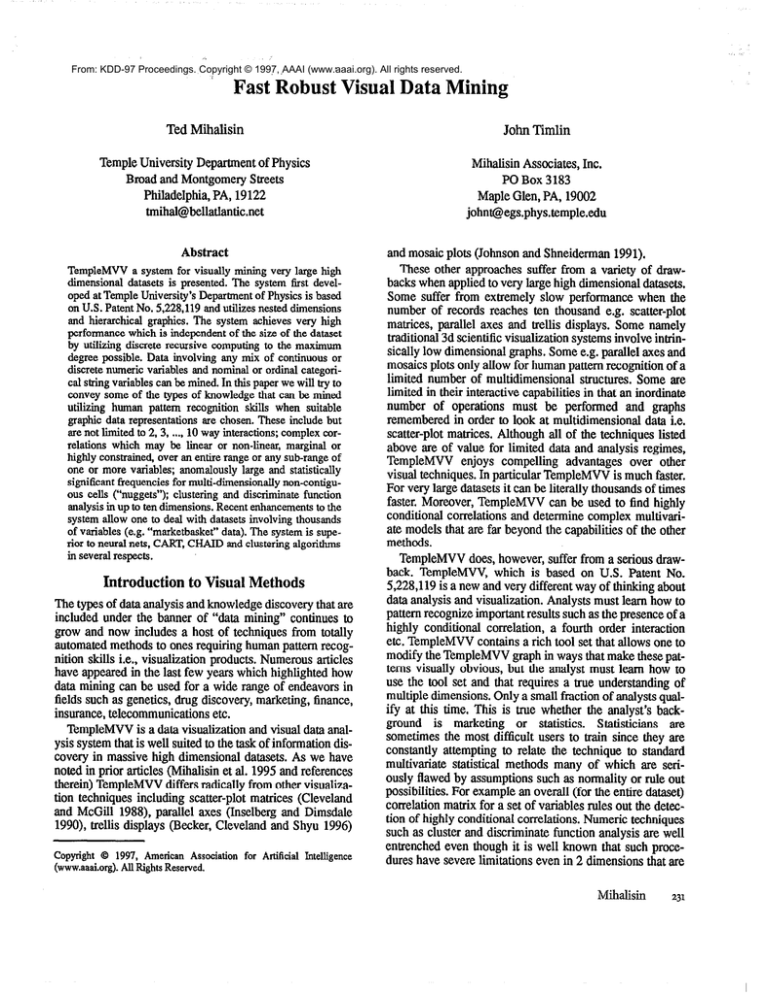
From: KDD-97 Proceedings. Copyright © 1997, AAAI (www.aaai.org). All rights reserved.
Ted Miialisin
JohnTimlin
TempleUniversity Departmentof Physics
Broad and Montgomery Streets
Philadelphia,PA, 19122
Mihalisin Associates,Inc.
PO Box 3183
Maple Glen, PA, 19002
tr&hr-all;C\l.ralln~lnnt;n
“,.lll~~-l,rruarlu~.l.~r
:,l.,‘a,n,
,l...”
h,..“,lJUL’L’~G~;S.~lL~~.“lll~lG.~U
ma+
Abstract
TempleMVV a system for visually mining very large high
dimensional datasets is presented. The system first &veloped at Temple University’s Department of Physics is based
on U.S. Patent No. $228,119 and utilizes nested dimensions
and hierarchical graphics. The system achieves very high
performance which is independentof the size of the dataset
by utilizing discrete recursive computing to the maximum
degree possible. Data involving any mix of continuous or
discrete numeric variables and nominal or ordinal categorical string variables can be mined. In this paper we will try to
convey some of the types of howledge that can be mined
utilizing human pattern recognition skills when suitable
graphic data representationsare chosen. These include but
are not limited to 2, 3, ..,, 10 way interactions; complex correlations which may be linear or non-linear, marginal or
highly constrained,over an entire range or any sub-rangeof
one or more variables; anomalously large and statistically
significant frequenciesfor multi-dimensionally non-contiguous cells (“nuggets”); clustering and discriminate function
analysisin up to ten dimensions.Recent enhancementsto the
system aiiow one to deal with datasetsinvolving thousands
of variables (e.g. “marketbasket”data). The system is superior to neural nets, CART, CHAID and clustering algorithms
in severalrespects.
Introduction to Visual Methods
The types of data analysisand knowledgediscoverythat are
included under the banner of “data mining” continues to
grow and now includes a host of techniquesfrom totally
automatedmethodsto onesrequiring humanpattern recognition skills i.e., visualization products. Numerous articles
have appearedin the last few years which highlighted how
data mining can be used for a wide range of endeavorsin
fields such as genetics,drug discovery, marketing, finance,
insurance,telecommunicationsetc.
TempleMVV is a data visualization and visual data analysis systemthat is well suited to the task of information disP,-,,IPN
vvrvs,
in
1.1 maoaiwa
. ..UYUI.”
h;mh
111&”
rl&nnnoinnol
-*.,“lli)l”Luu
An
Antwxsto
UUUWVW.
-
..,a
nu
ha.,n
IlcL””
noted in prior articles (Mihalisin et al. 1995 and references
therein) TempleMVV differs radically from other visualization techniquesincluding scatter-plot matrices (Cleveland
and McGill 1988), parallel axes (Inselberg and Dimsdale
1990), trellis displays (Becker, Cleveland and Shyu 1996)
Copyright @ 1997, American Associationfor Artificial Intelligence
(www.aaai.org).
All RightsReserved.
^A..
and mosaicplots (Johnsonand Shneiderman1991).
These other approachessuffer from a variety of drawbacks when applied to very large high dimensionaldatasets.
Some suffer from extremely slow performance when the
number of records reaches ten thousand e.g. scatter-plot
matrices, parallel axes and trellis displays. Some namely
traditional 3d scientific visualization systemsinvolve intrinsically low dimensionalgraphs.Some e.g. parallel axesand
mosaicsplots only allow for humanpattern recognition of a
limited number of multidimensional structures. Some are
limited in their interactive capabilities in that an inordinate
number of operations must be performed and graphs
rememberedin order to look at multidimensional data i,e,
scatter-plot matrices. Although all of the techniqueslisted
above are of value for limited data and analysis regimes,
TempleMVV enjoys compelling advantages over other
visual techniques.In particular TempleMVV is much faster.
For very large datasetsit can be literally thousandsof times
faster. Moreover, TempleMVV can be used to find highly
nn.wl:dl\..n,
b”llUlu”Ilal
n‘.,,,.1,,,:-..n
b”IIGIc\Ll”lI~
,%.,a
LlllU
,a,.4,-:,,
0GLG~ll‘llw
^^.-^I^..
uJllylGA
-..I&2...-:
IIIUIUVMI-
ate models that are far beyond the capabilities of the other
methods.
TempleMVV does, however, suffer from a seriousdrawback. TempleMVV, which is based on U.S. Patent No.
5,22&l 19 is a new and very different way of thinking about
data analysisand visualization. Analysts must learn how to
patternrecognizeimportant results such as the presenceof a
highly conditional correlation, a fourth order interaction
etc. TempleMVV contains a rich tool set that allows one to
modify the TempleMVV graph in ways that make thesepatterns visually obvious, but the analyst must learn how to
use the tool set and that requires a true understandingof
multiple dimensions.Only a small fraction of analystsqualify at this time. This is true whether the analyst’s background is marketing or statistics. Statisticians are
sometimesthe most difficult users to train since they are
constantly attempting to relate the technique to standard
multivariate statistical methods many of which are seriously flawed by assumptionssuch as normality or rule out
possibilities. For example an overall (for the entire dataset)
correlation matrix for a set of variables rules out the detection of highly conditional correlations.Numeric techniques
such as cluster and discriminate function analysis are well
entrenched
it *in well
hnwn ,..I thnt
cnrh &,s”.,“nrnrp.
---- -1------I even
-.-1-mthnnrrh
----p-- -.
.._.- --.v
. ..I. “I”..
dures have severelimitations even in 2 dimensionsthat are
Mihalisin
231
y 3rd H.C.
A
1’
2’
3’
4’
5’
Fig. 1 - A simple 4d space.In generalA, B, C, D can have
different numbersof bins/values.
Fig. 2 - Visual detection of a non-linear conditional correlation in 4D.
easily and instantaneouslyovercomeby simply looking at a
2 dimensional graph. The same is true for higher dimensionality.
(responsevariable or measure)for all recordsin each primitive cell. These sets of statistics include minimum value,
maximum value, sum of values, and sum of squaredvalues.
In addition find NR the number of records (data points) in
the primitive cell. These statistics allow TempleMVV to
recursively compute means,standarddeviation, etc. for collections of primitive cells consisting of cells with severalor
all values of one or more independentvariables (explanatory variablesor dimensions)and ultimately are responsible
for TempleMVV’s extraordinary speed.Fig. 1 shows variable A nestedinside variable C and variable B nestedinside
variable D. Fig. 1 also shows a primitive cell (PC.) as well
as first, secondand third hierarchicalcells (H.C.).
TempleMVV Basics
TempleMVV has 2 generically different types of computation phases.Namely there are “pre-process”phaseswhich
are unattendedand have computing times that scale with
the number of records. It is during the pre-processphase
that all of the cell statistics describedin section II) below
are computed,And there is the interactive visual data analysis phasewherein all computationsrequired for a new data
view are done recursively on the cell statistics. Hence all
operationsin this “human in the loop” visual data analysis
phaseare extremely fast. Below we give a 3 step procedure
for setting up the TempleMVV system:
I) Form a Discrete Space of Independent Variablesor IVs
(explanatory variables or dimensions)and Hierarchically
Arranged Cells
TempleMVV can handle any mix of categorical,ordinal
and continuous variables. But if a continuous variable is
chosento be an independentvariable (explanatoryvariable
or dimension) then it must be made discrete by binning.
Categorical and ordinal variables are of course discrete at
the Outset.If there are nA bins/valuesfor variable A, ng for
B etc. then the total number of primitive cells is nA x ng x
nc x ... The size and/or color of a symbol such as a vertical
bar is going to representa scalarnamely a statistic that representsall the recordsin the primitive cell.
II) Compute Dependent Variable (response variable or
measure)Statisticsfor All Recordsin Each Primitive Cell
Once the nature of the primitive cells is defined compute
a set of statistics for each dependent variable or DV
232
KDD-97
III} Provide Tools to Alter the Multidimensional Space
These tools allow one to select subsetsof bins, combine
bins and changethe nesting order of IVs (explanatoryvariablesor dimensions).All resulting recomputationsare done
recursively.
Conditional Non-Linear Correlation
Consider4 variables A, B, C and D. Shown in Fig. 2 is an
MVV graph in which the dependentvariable is number or
count i.e. the number of data points. There are 9 values for
A and 9 for B, 5 for C and 5 for D. A color map (herea gray
scale map) is used to indicate the value of N. As N
increasesthe color evolves from red for small N to blue for
large N just as in a rainbow. For the gray scale version red
is a fairly dark gray (see the region where C = 1 and D = 1
in the graph) then lightens as N increasesto intermediate
values and then darkens again for high N values (see the
centerof C = 3, D = 3 region of the graph where N is greatest). Each of the graphsof N(A, B), (i.e. one for each of the
5x5 = 25 values of the C, D doublet) has N maximum in the
center and falling off symmetrically away from the center
important example of this is the “marketbasket” problem
where one is interested in knowing which products are purchased together. If one is oniy interested in a handfui of
general product categories (say 10) then this problem can
be addressedby the standard TempleMVV computational
engine. In fact only one DV (responsevariable or measure)
is required namely the percent of customers and the IV
(explanatory variable or dimension)_spacewould consist of
10 two state variables of form A or A meaning bought A or
didn’t. The resulting number of cells would be 21° = 1024.
On the other hand this “IV approach” quickly becomes
impossible as the number of products grows. A typical grocery store or auto supply house etc. might sell 10,000 difFig.3 - Probability of purchasing A, B with no constraints
and subject to the purchaseof 1 or 2 other products.
except for one. For C = 4 and D = 3 there is an easily detectable non-linear (in fact quadratic) correlation of A and B.
Visually the non-linear and conditional correlation of A and
B is quite obvious and yet a correlation matrix for this data
would return zero for all matrix elements. Moreover, even
if we took a subsetof the data namely the C = 4, D = 3 subset and then evaluated the A, B element of the correlation
matrix we still would a---zet a zero
~- result due to the non-linear
nature of the correlation. This is one of many examples
where conventional multivariate statistical procedures produce invalid results. On the other hand CHAID basedproducts would detect the effect if and only if they go to the
appropriate depth i.e. checking for x2 in an AB Spacefor C
and D constrained.
Unfortunately space does not allow us to demonstrate
how TempleMVV allows one to visually discover clusters
that are missed by clustering algorithms.
Extending TempleMVV to 100 DVs
TempleMVV allows one to display multiple DVs as either
stacked bars or as individual symbols (bars, circles, boxes
or color maps) in subcells. As stated above each DV other
than count (number of records) requires that certain statistics for all records in each primitive ceil be computed and
stored in RAM. This requires 40 Bytes per primitive cell
per DV. Hence for 100 DVs, 4KBytes of RAM per primitive cell are needed. In addition other overhead takes 110
bytes per cell for a total of 4.11KBytes per cell for 100
DVs. Assuming say 10,000 primitive cells a system with at
least 41.1 MBytes of RAM would be required. Thus PCs
and UNIX workstations can be used even when there are
hundreds of DVs (measures or response variables) if the
number of primitive cells (given by the product of IV bins/
values) does not exceed 10,000. There are of course situations in which the number of primitive cells is considerable
less than 10,000 which would allow for a correspondingly
larger number of DVs.
Extending TempleMVV toThousands of DVs
Certain datasetsinvolve literally thousandsof variables. An
flwant
l”l”ILL
nrna,rPt@
pvuuvw
onrl
&u&U
71
O*~;_!Q3fx)O
..mnlA
W”YIU
km
“Y
un
.,PFS,
““.J
larrrn
lrugv
number of primitive cells. If instead one adopts a “multiple
DV” approach one could generate a set of DVs (response
variables or measures) for single items, a second set for
item pairs etc. However even going to depth 2 i.e. finding
the probability or frequency of buying A given that one has
purchased B and comparing it to the marginal frequency
would imply on the order of 10,0002= 10”cases.
Thus it would appear that for 10,000 items going beyond
depth 3 (i.e. 2 constraints) is not feasible. However, there
are in fact practical considerations that greatly simplify the
problem and allow one to ueo to
~~”meater
-~~- denth.
--r- ~-The first simplification arises because one is usually not interested in
analyzing all 10,000 items only a small subset. Moreover,
one is not interested in the leveraging of product A by
another B if B is rarely bought. Usually the subsetof leveraging items consistsof the top n selling products.
Consider the case where there are 100 leveraging items
and we are interested in analyzing 10 products. It would
appear that one would need to consider ( 1OO)2pairs as constraints for a depth 3 analysis, ( 1OO)3triplets for depth 4 etc.
for each of the 10 products. But the number of pairs, triplets
etc. are far smaller if one uses the same threshold concept
i.e. that only pairs, triplets etc. with purchase probabilities
above the threshold should be considered. In fact the number of each cannot exceed 100 and can be considerably less.
Moreover, extremely fast algorithms can be employed to
locate the 100 or fewer pairs, triplets etc. Hence one has a
fast robust system for finding all of the important nuggets!
TempleMVV has been modified for the marketbasket
problem. Non-product variables such as the buyer’s age,
income, gender, education etc. or store related variables
become MVV IVs (explanatory variables or dimensions)
and the resulting primitive cells define record subsets.
Shown in Fig. 3 is a simpie exampie of muitipie DVs
(response variables or measures) that would go into one
primitive cell. They are the probabilities of buying product
A and of buying B with and without constraints and their
binomial uncertainties which are indicated by the thickness
of the horizontal line at the top of each vertical bar. In the
first column labeled 0 for 0 constraints the probabilities are
computed with no constraints. In the next 5 columns
labeled l-l to 1-5 are the top 5 probabilities when there is
one constraint i.e. that one particular product has also been
purchased.In the last 5 columns labeled 2-1 to 2-5 are the
Mihdisin
233
top 5 probabilities when there are 2 constraints i.e. that 2
particular products have also been purchased. Of course
which product correspondsto l-l or 1-2 etc. differs in general for product A and product B. One can read which products correspond to l-l through 1-5 and 2-l through 2-5 for
product A or for product B by clicking on the appropriate
row. The 3 most im rtant “nuggets” of information are the
high values of Pu ‘- PO
, PA2-l andPA2-2.FOrViSUd Clarity Only
2 individual products namely A and B are shown in Fig. 3
and only 5 single product and 5 product pair constraints.
These numbers can be increased and the constraints can
include triplets etc. Remember that Fig. 3 shows the probability of purchasing A with no constraints and with 1 or 2
other products for one particular primitive cell of TempleMVV, that is, for one age group-gender-incomebracket
etc. Clearly changesin the size and decay rates from l-l to
1-5 and from 2-1 to 2-5 of the vertical bars (the probabilities) as well as changes(if any) of the identities of products
l-l etc. as one moves from one primitive cell to the next
would reveal important marketing information.
TempleMVV vs. Other Methods
When comparing data mining tools severalissuesshould be
addressed,First, what are the types of knowledge that can
be discovered by the tools? Second, is there any guarantee
that the tool in the hands of a knowledgable user will discover all relevant information of a given type or at least the
most important information? Third, does the tool provide a
meansfor evaluating the importance of the discovery in the
context of competing discoveries of the samegenre. Fourth,
since combinatoric complexity prevents (for non-trivial
datasets)the completion of exhaustive searchalgorithms (in
a human lifetime), does the tool lend itself to interactive
analysis in which answers lead to new questions which can
be addressedby the sametool? Fifth, is the tool fast enough
for truly interactive analysis? Sixth, to what depth does the
tool allow one to obtain results? This is a vital issue since
analysis involving no constraints or the constraint of only a
few variables (i.e. “shallow” analysis) can yield very misleading results. Seventh, what are the limitations of the tool
in so far as the size and complexity of the data that can be
analyzed?In particular can the tool be applied to all the data
or must one select a relatively small subsetof say 10,000 to
100,000 points and hence severely limit the depth of the
analysis?Eighth, can the tool lead to accuratemodels of the
data even in the limit of “complete” complexity as in a fully
saturatedlog-linear model?
On the basis of these issues TempleMVV has decisive
advantagesover neural nets, CART, CHAID and clustering
algorithms. TempleMVV can be utilized to perform all of
+rmnn
r.C nrrnl.m:n
nn~.L-nA
I.., l hhnnr.
tnr\ln
~Krrmn..n..
A.,.
Ll‘ci l;ypa
“1 culalybla
ycxi”~l,Ku
“y
LUGS2
WI&
I”I”IW”c7I,
utilizing human pattern recognition capabilities it can discover data patterns that elude the other tools. Patterns
which can be found by one or more of these tools can be
discovered far faster using TempleMVV. TempleMVV’s
fully recursive computing allows it to deal with far more
data and hence pursue an analysis of greater depth than the
other tools. TempleMVV not only allows one to find the
234
KDD-97
most important information of a particular type but also
allows one to view the information in context. TempleMVV’s graphical views of the data and sub-secondresponse
allow for truly interactive exploratory data analysis and
knowledge discovery. Finally, TempleMVV’s nestedhierarchical graphics and built-in fitting routines allow one to
model complex information.
Spacedoes not allow us to detail all of the shortcomings
of the other tools. However, some should be highlighted.
Neural nets cannot guarantee that one has found the most
important nuggets of information and do not provide context or an interactive exploring analysis environment.
CART suffers from a lack of depth in that it only looks at
one or at most two variables ahead and can lead to very
deceptive results. CHAID has four important drawbacks.
First, for computational reasons it utilizes limited depth.
Secondit involves a procedure which aggregatessquaresof
deviations over a variable’s entire domain and hence can
undervalue striking deviations that occur over sub-domains.
Third it does not provide a framework for understanding/
modeling data. Fourth it does not provide an interactive
analysis environment. Finally, Clustering algorithms are
extremely limited in function and in terms of the number of
data points they can handle. In addition, they cannot detect
inter-penetrating filamentary structures. Moreover, the
commonly held view that the use of a complete set of neural
net, CART, CHAID, clustering and standard visualization
tools can overcome these limitations can be shown to be
unrealistic. We believe that these are compelling reasonsfor
analysts to invest the time required to learn the new data
analysis methods provided by the TempleMVV system.
References
Becker, R.A.; Cleveland, W.S.; and Shyu, M.J. 1996. The
Visual Design and Control of Trellis Display. Journal of
Computational and Graphical Statistics 5: 123-155.
Cleveland, W.S., and McGill, M.E. eds. 1988. Dynamic
Graphics for Statistics. Belmont, Calif.: Wadsworth and
Brooks/Cole.
Inselberg, A.; and Dimsdale, B., 1990. Parallel Coordinates: A Tool for Visualizing Multi-dimensional Geometry.
In Proceedings of the IEEE Conference on Visualization,
361-375. San Francisco, Calif.: IEE Press.
Johnson, B.; and Shneiderman, B.,1991. Tree-Maps: A
Space-Filling Approach to the Visualization of Hierarchical
Information Structures.In Proceedingsof the IEEE Conference on Visualization, 284-291. San Diego, Calif.: IEE
Press.
Manly, B.FJ. 1986. Multivariate Statistical Methods. London, England: Chapman and Hall.
Mihalisin, T.; Timlin, J.; Schwegler, J.; Gawlinski, E.; and
Mihalisin, J. 1995. Visual Analysis of Very Large Multivariate Databases.In Proceedingsof the Section on Statistical Graphics, 18-27. Orlando, Florida: American Statistical
Association.


